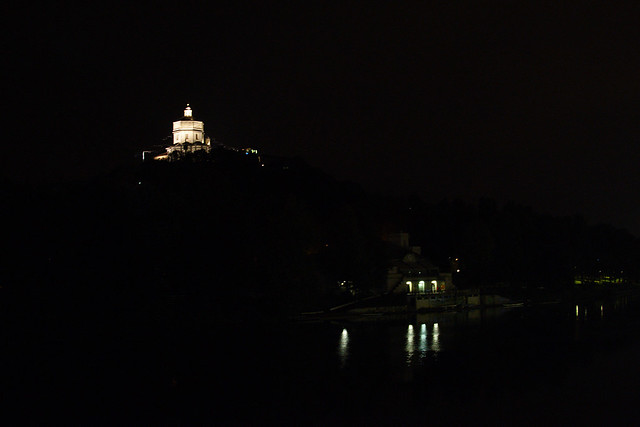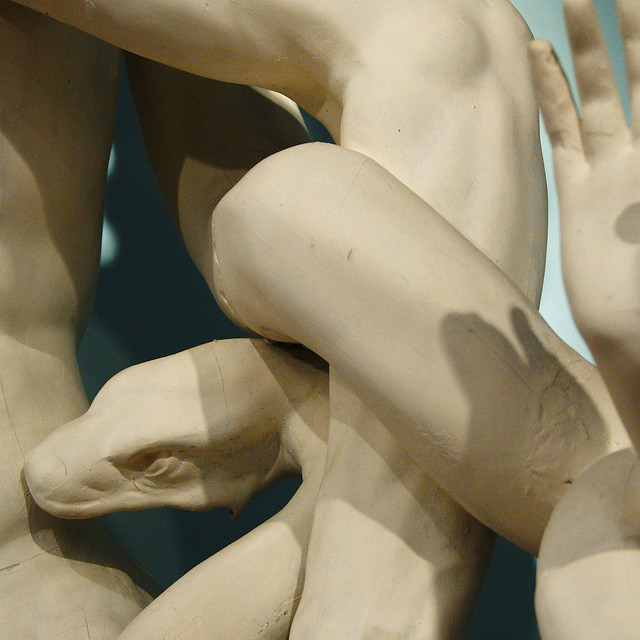Month: February 2014
Pilgrimage with Simon Reeve; Survivors: Nature’s Indestructible Creatures
Pilgrimage with Simon Reeve was a three part series that was partly a travelogue and partly about the history of Christian pilgrimage across Europe and the Holy Land from medieval times through to the modern day. Reeve made it pretty clear several times that he’s not a Christian himself, so this was an outsider’s view on the subject. He did, however, talk to several people who do pilgrimages for religious purposes today, so we got both sides of the subject represented. The first episode started in Lindisfarne and made its way down to Canterbury and mostly talked about medieval experience of pilgrimage. Then the second episode went through France and Northern Spain to Santiago de Compostela, and then across the alps to Rome. The third episode went from Istanbul to Jerusalem (via Bethlehem).
Reeve seemed focussed primarily on the question of what people get out of pilgrimage. His conclusions were that as well as the visiting of spiritually significant sites the journey itself has spiritual benefits for the people who do pilgrimages. They have a time to step outside of their daily lives and reflect on how they’re living and what they’re doing with their lives. Be that in a religious sense or a purely spiritual sense, various of the modern pilgrims he talked to weren’t people who called themselves Christian.
It wouldn’t be a Simon Reeve programme if it didn’t also look at the less uplifting parts of the subject! In the last episode there he was travelling through the West Bank (as one has to, if one’s visiting Bethlehem), and took the opportunity to contrast the modern political situation with the spiritual significance of the region to so many people. Another example was his visit to a very modern cult centre – the town where Padre Pio lived, who died in 1968. This has a massive new cathedral, a TV station of it’s own (run by monks), lots of fancy hotels in the town for all the touristspilgrims. And various rumours of how he kept his stigmata open during life by the judicious application of carbolic acid … He was canonised, but Reeve implied that was more an attempt by the Vatican to keep it in house so’s to speak. The cult was growing up anyway, so he was officially made a saint.
An interesting series 🙂 And in a piece of serendipity the first episode overlapped in subject matter with the end of Neil Oliver’s recent series about Sacred Wonders of Britain that we’d just finished watching (post). The second episode had some overlap with the second episode of Waldemar Januszczak’s series about Baroque art which we’re also watching at the moment. The three presenters have very different styles so it was interesting to get the various perspectives all so quickly together!
The other series we finished watching this week was Survivors: Nature’s Indestructible Creatures – a three part series about species that didn’t die out in mass extinction events presented by Richard Fortey. Each episode covered a different extinction event, and Fortey tracked down 10 species that survived it through to modern times. The first one was about the Great Dying (which occurred 252 million years ago) which is the most significant extinction even with the greatest die-off of species. For this one he looked at things like horseshoe crabs, sea cucumbers and lampreys. The second covered the KT boundary – i.e. death of the dinosaurs, so had an emphasis on birds, mammals and crocodiles. And the third one looked at the Ice Age and at the cold adapted species that made it through to our own times.
This was definitely more my sort of thing than J’s. I thought it managed to combine a bit of geology, a bit of evolutionary biology and a bit of modern day travelogue into an interesting whole (even tho I think I knew of most of it before, it’s nice to actually see things sometimes). Fortey was an engaging presenter, who was also pretty entertaining as he tried to handle live specimens with varying degrees of success and comfort. I had a great deal of sympathy with that as someone who’s significantly worse at handling live animals than he was yet is still a biologist 🙂 Oh, and it also had a running theme of Fortey eating some of these survivors & telling us how they taste, which was a slightly odd (but fun) addition.
Other TV watched this week:
The Coffee Trail with Simon Reeve – one-off programme about coffee growing in Vietnam. Vietnam is the main supplier of coffee for the instant coffee trade, and it’s as exploitative a trade as you’d expect. The regime in Vietnam isn’t particularly nice either.
Episode 2 of Baroque! From St Peter’s to St Paul’s – gloriously over the top series about Baroque art and architecture, presented by Waldemar Januszczak.
Episode 1 of The Stuarts – a series about the Stuart Kings of England & Scotland, presented by Clare Jackson, and about how they shaped the United Kingdom and how they were shaped by it. Broadcast on the Scottish version of BBC2 only.
Nigel Slater’s Great British Biscuit – a similar programme to Slater’s previous one on sweets (post), part nostalgia, part history of biscuits. Lots of “oh I remember those” moments 🙂
Greek Myths: Tales of Travelling Heroes – programme presented by Robin Lane Fox about the early Greek myths about the origins of their gods. Also looking at the links between the mythological stories and the landscape the Greeks knew, and also the links to Hittite mythology. We both had quite a lot of deja vu watching it, and figured out eventually that we’d watched it before about 3 years ago and had just forgotten (brief post on my livejournal). Interesting & worth watching, even for a second time 🙂
In Our Time: Cosmic Rays
We’re back to listening to episodes of In Our Time on Sunday mornings. The one we listened to this week was about that staple of 1930s science fiction – cosmic rays. The three experts who were talking about the reality of this phenomenon were Carolin Crawford (University of Cambridge), Alan Watson (University of Leeds) and Tim Greenshaw (University of Liverpool).
Cosmic rays were discovered about a century ago. The first indications that they existed came from detection of increasing radiation levels as you go higher up in the Earth’s atmosphere. At first they were assumed to be photons and the name “cosmic rays” was coined. This turns out to be a misnomer, they are in fact charged particles – bits of atoms. Some of them are atomic nuclei, some are electrons and some are more exotic things like positrons. They travel at a variety of speeds, from a variety of sources. Crawford told us that they are categorised into three broad groups. The first of these are relatively slow-moving particles that come from relatively local sources – the sun for instance – and are very common. These are the particles that are involved in creating the Aurora Borealis. The next group are moving more quickly, and come from further away – generally these are thought to be generated as as side-effect of supernova explosions. And the last group are the fastest moving and are thought to be from outside our galaxy, these are the rarest type of particle.
The particles aren’t detected directly (on Earth) instead what we detect is the side-effects of these particles hitting the Earth’s atmosphere. As the particles collide with atoms in the upper atmosphere they generate a shower of secondary particles and it’s these that are detected. The types and numbers of these particles can be used to work out what hit the atmosphere, how fast it was going and the direction it was travelling. We know they are charged particles (and which charge) because of the effects of the Earth’s magnetic field – the number of particles hitting the atmosphere varies with latitude with most of them at the poles. This is also why the Aurora Borealis are mostly at the poles. That phenomenon is formed by the particles exciting the electrons in atmospheric atoms, when the electrons return to their original energy states they emit light. They went off into a slight digression on the programme when talking about this – predicting the Aurora Borealis requires prediction of solar weather and that’s being worked on because particularly bad solar weather can lead to EMPs that can affect satellites.
All three experts agreed that the fastest moving group are the most interesting – in part because we still don’t know much about where they come from or how they’re generated. They’re pretty rare, so a normal sized detector (I don’t think they said how big) would only detect about one a century – so Watson was talking about a project he helped set up that built a detector the size of Luxembourg and this detects 3 or 4 of these rare particles a year. One theory of where they come from is that they are generated in galaxies with super massive black holes at the centre. Another is that they have something to do with dark matter.
Particle physics as a discipline grew out of the study of cosmic rays. The Large Hadron Collider does under controlled conditions what cosmic ray particles do when they hit the atmosphere. This is another reason why the fastest particles are the most interesting – they travel at a much higher speed than the LHC can achieve. The fastest moving particles travel faster than the speed of light in air, generating Cherenkov radiation. Again the programme took a little digression to explain this. Light travels at different speeds in different media – and so these particles aren’t travelling faster than light does in a vacuum (like the space the particle was just travelling through), it’s just that they don’t slow down when they enter the atmosphere. So the radiation that is released in front of the particle is moving slower than the particle and so can’t move away from the particle. It’s effectively being pushed along in front of the particle and that’s what we detect as Cherenkov radiation. It’s a bit like the sonic boom you get when something breaks the speed of sound.
As an aside – something I didn’t know before was that 14C dating is a direct result of cosmic rays. The 14C in the atmosphere is generated by cosmic ray particles hitting nitrogen atoms, if cosmic rays didn’t exist we’d not have such a good way of dating organic material (like bones).
Future work on cosmic rays is quite concentrated around figuring out what the fast ones are. There is also data being gathered more directly on the particles involved. The ISS currently has a cosmic ray detector fitted to the side of it, which has been gathering data since 2011 and is planned to continue for ten years.
Blackfield (Koko, Camden 5 February 2014)
On Wednesday there was a tube strike but we had tickets to see Blackfield play in Camden so we went in anyway. We changed our plans for the rest of the day a little because I didn’t want to buy timed entry tickets to an exhibition when we weren’t quite sure how the journey would work out. In the end it all worked out OK – I had an app on my phone (Citymapper) that gave us bus routes and times to & from Cockfosters (where we parked) and showed us where to walk while we were in Central London. We got lunch at the Northumberland Arms near Euston station, which was very tasty (and I had a rather nice pint of Bateman’s Chocolate Biscuit Beer). Then off to the British Museum for the afternoon – we didn’t have a plan there, we just wandered through a few galleries looking at the things that caught our eye.
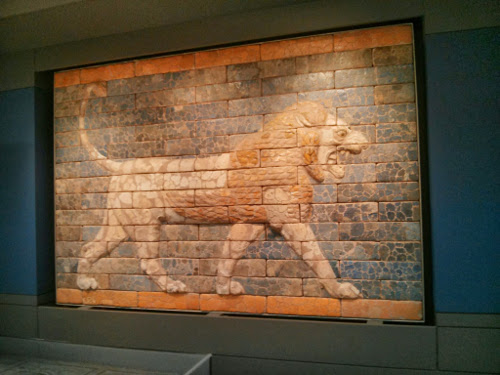
Including a Babylonian lion – I’d forgotten they had one on loan at the moment. No camera with me just my phone, which I’m trying to use the camera on more when it’s all I’ve got there. I’ve put an album of photos up on G+ here.
We met up with our usual gig going companions (Paul and Ady) around half five and had dinner in a pizza place in near the venue called Chicco’s – enormous portions of rather tasty food. The starters were a mistake, given the size of the pizzas – my fault, I was too tempted by the prawn cocktail so I persuaded everyone to join me in having a starter. Besides, the prices were quite cheap so I didn’t think the portions would be large.
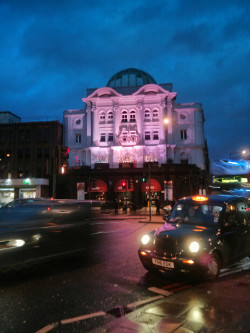
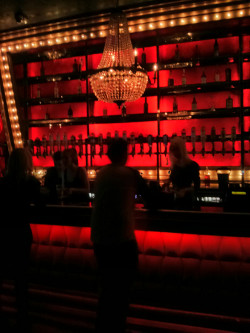
And then onwards to Koko. Not somewhere I’d been before – I think Paul had seen Marillion play there, but it was a gig J & I hadn’t gone to. Outside quite plain (although rather pink) but it was quite an eye catching venue inside – lit in red with ornate decoration. And a fairly varied selection at the bar too (I had Theakston’s Lightfoot, which I hadn’t seen before).
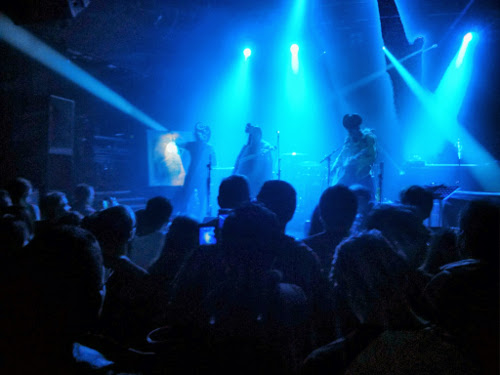
The first support act were an Australian band called The Red Paintings. They said they were playing stripped down versions of their songs – just two musicians and one artist on stage, rather than a full band and more artists. They were unique, that’s the only way to describe them – and it was very much a performance rather than just some music, if that makes sense. The two musicians were a singer/guitarist and an electric violin player, I’m not quite sure how to describe their music except that it was energetic. Oh, and they opened with a bit of audio from Donnie Darko and did a cover of Tears for Fears “Mad World” later on so that gives some of the ambience. Part way through the first song an artist came on stage dressed in black with lights making patterns (an “alien”) and painted a painting on stage while the musicians played. I’m not sure I particularly need or want to see the band again, but it was a fun start to the gig.
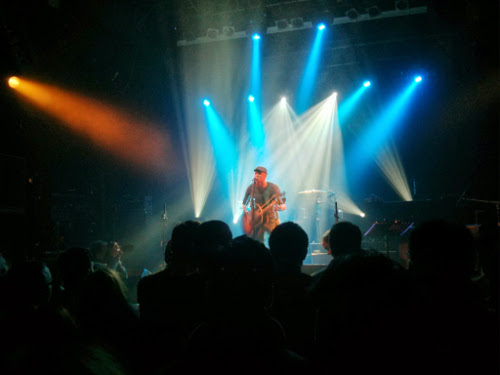
The second support act was Dave McPherson who was billed as being “from InMe” – to which my only reaction was “who?”. It was a one man & his guitar show, and although when it started I was a little dubious once he settled into the performance he was rather good.
After his set as is traditional the tallest man in the venue decided to stand directly in front of me. I was a little startled as I thought I already had someone fairly tall in front of me! But the one that showed up just before Blackfield was significantly taller – and significantly taller than J, too. Oh well, I still managed to see a bit, then later the way things moved around meant he was off to one side so that was a lot better. Talking of the audience I also discovered that while I don’t mind people taking photos of the bands (I do it too, after all) I find audience shots, panoramas/photospheres including the audience and people resting their arms on my head to steady the camera all deeply deeply tedious! Particularly the last.
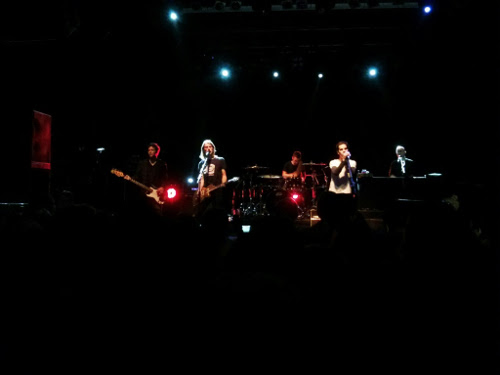
Blackfield are a project that is a collaboration between Steven Wilson (of Porcupine Tree) and Aviv Geffen (an Israeli rockstar), with a band of Israeli musicians. Originally Wilson & Geffen were co-leaders of the band, but Wilson’s been stepping back recently due to other bits of his career taking up more time – after this European tour he’s not going to be part of the band at all. Their music is towards the poppy end of the rock spectrum and while I wouldn’t call it happier than other Steven Wilson related stuff it sounds more upbeat and cheerful (and then you listen to the words … 😉 ). I think my favourite of the albums is the first one – and this gig included a lot of tracks off that album so that was cool 🙂 Here’s someone else’s video of one of the tracks off that album, played in Philadelphia a couple of years ago:
It was a good day out, and a good gig 🙂
Next Generation
Easter Island: Mysteries of a Lost World; The Search for Alfred the Great
Easter Island: Mysteries of a Lost World was a one-off 90 minute documentary about the history of Easter Island presented by Jago Cooper. The canonical story about the Easter Island culture is that they became so obsessed with building the Moai statues that they cut down all the trees to move them around, at which point the soil promptly eroded away and the culture collapsed due to being unable to grow food. Violence, destruction of statues and cannibalism followed. There’s then a moral lesson drawn about what we, the modern global society, should learn about using up all your resources.
The thesis of Cooper’s programme is that when you actually examine the evidence it’s clear that the traditional story is wrong. Over the course of the programme Cooper talked to several experts in the history and archaeology of Rapa Nui (the proper name for Easter Island and it’s people) both from Rapa Nui and from other countries. The experts didn’t always agree on the details (most notably about the date of arrival of people on Rapa Nui) but the overall picture was clear. Easter Island is the last inhabited place on Earth to become inhabited, somewhere between 100AD and 1200AD. As the Polynesians spread out into the Pacific Ocean they had a standard method of colonising new islands. A group would go out in boats looking for new lands, and when they found something suitable they’d take note of where they were then plant some yams and return home. A larger colonisation group would then set out with all the amenities they’d need to set up a self-sustaining society, and by the time they got there they would have yams to eat. Rapa Nui was the last island found in this eastward migration, and because it’s so far from any other land it became isolated after it was settled. From whenever that was till the arrival of the first Dutch ship in 1722 AD the Rapa Nui people believed themselves to be the only people in the world, and the island was the only land in the world surrounded by an endless sea.
Rapa Nui was forested when the islanders arrived, and did become deforested over the next several centuries. However, this wasn’t anything to do with moving statues and wasn’t even a catastrophe. Cooper told us that the statues are more likely to’ve been moved by “walking” them using ropes, rather than pulled on wooden runners. And even if they were using wood to move their statues, it wouldn’t’ve needed that many trees. One of the experts interviewed had done the calculations – he knew how many trees could’ve grown on the land, how many trees you’d need to cut down to move a single statue a particular distance, how many statues had moved how far. And it was an insignificant number of trees to move all the statues using wood, as compared with the starting number.
Instead of being the results of foolish disaster it’s much more likely that the trees were cleared to create space to grow crops just as is the case in other places around the world. The Rapa Nui people used several methods to keep the soil thus exposed both there and fertile. One things they did was to use rocks to cover the fields in a technique called “stone mulching” (I didn’t quite understand how this worked beyond the obvious idea that the rocks stopped the soil from blowing away – wouldn’t it also stop plants from germinating?). There is also evidence that they landscaped areas so as to collect and channel water – the only fresh water on the island comes from rain – and they planted trees in the damper areas generated by this. And they planted some crops (like banana trees) in caverns where the roofs had fallen in – shaded and out of the wind.
When the first ships arrived, on Easter Day 1722, they found a vibrant and healthy society – which was rather surprised to find it wasn’t alone in the world. That visit was brief, and amicable. When the next ships arrived, about 50 years later, they found a much reduced population and notably that the Moai statues were toppled over. What had changed? The traditional story involves civil war and cannibalism, but there’s no archaeological evidence for that at all. Instead Cooper said the most plausible explanation is that European diseases caused a severe drop in population in this previously isolated society. I think he said that 90% of the population is thought to’ve died – and so of course you have societal changes, that’s a very traumatic event. The statues show signs of being deliberately lowered to hide their faces. One possible explanation is that the honoured ancestors who were supposed to protect them had failed so were toppled. Another is that the Rapa Nui wanted to hide what had happened to their people from the ancestors, so this was a way of covering their eyes. Society was still basically healthy, however, as shown by the evolution of new rituals (like the birdman cult).
And then the European powers did what they did so often – many of the natives were taken off as slaves to work in South America. Those who remained were forced to live in only one small part of the island and poorly treated, while the rest was given over to intensive sheep farming. This use of the land is what caused the soil and the ecosystem to become as poor as it is today. At one point in the 19th Century there were only 36 families on Rapa Nui who had children – and all the native Rapa Nui people today are descended from these people. The culture has only survived in fragments from oral histories written down in the early 1900s – these same fragments are what started the modern fascination with Easter Island. The modern Rapa Nui are fiercely proud of their island, and its history, and are trying to get independence from Chile (their current political rulers).
This was a fascinating programme, well worth watching. Cooper does get a little carried away with how perfect life was before the Europeans arrived, but I think that’s partly to highlight the contrast between the traditional story about the island and what the evidence tells us.
Another one-off programme that we watched this week was The Search for Alfred the Great. This was presented by Neil Oliver and followed the recent attempts to find the bones of King Alfred. The structure of the programme was three intertwined strands – a biography of Alfred, the history of his bones after his death and the scientific examination of the bones we have.
The biography of Alfred didn’t really tell me anything I didn’t already know – we’ve recently watched Michael Wood’s series about Alfred and his heirs (post) which covered the subject in more depth. The history of Alfred’s bones was new to me, however. His body has been moved at least twice since his original burial. These initial two moves are well documented – he was buried first in the Old Minister at Winchester. Then after completion of the New Minister (that he himself set in motion) he was reburied there. After the Norman Conquest there was another rebuilding of the church (to its current form) and the monks associated with the first New Minister were moved to somewhere else – Alfred was reburied in their new abbey. After the dissolution of the monasteries during the Reformation the story of Alfred’s bones gets more murky – they stayed buried as the abbey was demolished around the graves and were forgotten to some extent. When the area was redeveloped into a prison in the 18th Century the convicts doing the ground breaking for foundations discovered sepulchres and bones – the valuable bits were sold, the bones were scattered. But an antiquarian did write about it, and about how these might’ve been Alfred & his family’s tombs. Later a Victorian claimed to have re-found and re-dug up these bones – eventually those were bought by a local church which re-interred the bones in the churchyard with a note that they were probably Alfred. This Victorian is the dodgy link in the evidence chain.
And this is where the modern analysis comes in. The bones from the churchyard were exhumed and analysed using modern techniques. I was a little surprised when near the end of the programme the carbon dating all came back as “too recent” – the 5 skeletons in the grave dated between 1100 AD and 1500 AD. Surprised because I thought I’d read that they’d found something plausible. All became clear shortly afterwards when Oliver moved on to talk about a modern partial excavation of the disturbed abbey site. This had turned up a few bits of human bone but funding had run out before proper analysis was done. Carbon dating on a fragment of a man’s pelvis indicated a date of ~900 AD, so the right era. There is nothing to say if it’s Alfred or not, but it’s possible. The main take home message is that it is likely worth excavating the rest of the site properly so see what else might be found (if anything).
An interesting programme. And well done to Oliver and the other people involved in making it for making a programme that was still worth watching even tho the central question wasn’t answered!
Other TV watched this week:
Episode 2 of Survivors: Nature’s Indestructible Creatures – series presented by Richard Fortey looking at three mass extinction events and showing us modern examples of the species that survived them.
Episode 2 of Pilgrimage with Simon Reeve – a programme about the history of (Christian) pilgrimage, pilgrimage sites and the modern incarnation of it.
Episode 1 of Baroque! From St Peter’s to St Paul’s – gloriously over the top series about Baroque art and architecture, presented by Waldemar Januszczak.
The Making of the Modern Arab World: Episode 4
The fourth and final episode of Tarek Osman’s Making of the Modern Arab World covered the 10 years leading up to the events of the Arab Spring in 2011. Osman drew out three strands that he felt were important in that decade. One of these is the growing population of the Arab countries. Osman said he’s 38, and in his lifetime the population of Egypt has doubled. Two thirds of the country is under the age of 25. The available jobs and opportunities for these young people haven’t kept up with the growth of the population, and that has had a large impact on the way people see the future (both their own and the country’s). Osman talked to an activist who said she felt that Egyptian society was stuck, like being stuck in a traffic jam.
Another strand of events leading up to the Arab Spring was that the authoritarian leaders of these nominally democratic republics were all getting old. And instead of these being a point where the people could hope for change, it became clear that they were grooming their sons to lead after their deaths. Osman said that when Hafez Al-Assad’s son took power in 2000 at first the general population thought this might bring change – Bashar Al-Assad being young and educated in Britain, perhaps he would be less authoritarian. But it quickly became clear this was not the case, and that meant people in other countries in the region didn’t even have hope that things would change when their own leaders passed away. And this added to the sense of almost insult at the overt handing down of power to sons rather than any pretence at democracy.
Information, and access to it, was the final strand of this narrative. This has two facets – the first of these is that the regimes lost control of the information that their citizens could access. The rise of the internet, and with it the rise of globally accessible media, meant that the general populace was much more aware of what was going on in other countries. And that people could communicate, and organise, much more effectively. Osman talked to an activist who would organise protests on facebook, with 70,000 people who followed his facebook page – you can’t get that sort of reach with more conventional organisation.
The other facet of this strand is the lack of information that the regime had. Osman talked about how Mubarak and the other leaders over time became more set in their ways, and more isolated from the general populace. They weren’t concerned with what the general public thought – dismissing them as unimportant. Osman didn’t say this outright, but I think he was saying that the centre of these regimes didn’t even know they’d lost control of what information their people were seeing. A couple of different civil servants from the Mubarak regime talked about how Mubarak wasn’t interested in change nor was he interested in planning ahead. One said that he had tried to suggest change in the education system to keep up with the demands of modern global society, but that Mubarak wasn’t interested. Another anecdote was that when talking about trying to fix future problems Mubarak’s attitude was that there was enough to do to fix the problems of today, so why add more problems. Whereas the civil servant felt that if you looked at tomorrow as well you might solve today’s problems a different way.
These strands all came together in the actual events of the Arab Spring – where one man’s suicidal protest in Tunisia was seen by other disaffected young people across the whole region, instead of being covered up by the regime. And once seen they could react, and act. The results of the Tunisian uprising then inspired other country’s in turn. Osman ended the programme on a bittersweet note – he talked to a woman who’d taken part in the Egyptian protests that drove out Mubarak. She reminisced about how it felt like they had risen up and become free and made something better. And she hoped perhaps one day her country would manage to sustain that.
The series as a whole has been interesting. However, for all it says in the title it’s a history of the whole of the modern Arab world the focus is firmly on Egypt. Not that surprising, as that’s Osman’s country. It was definitely interesting hearing the history from an Egyptian perspective, rather than an outsider perspective.
“Vanished” Kat Richardson
Vanished is the fourth book in Kat Richardson’s Greywalker series – I’m getting these out of the library so sadly I skipped over book 3 because the library don’t have it. I don’t think this’ll be a long post – I’m not sure how much I can say about this book while staying spoiler free. When I started reading the series I thought they were going to be very episodic monster-of-the-week stuff, but this one (and perhaps the last one too, I don’t know) is much more concerned with series arc. And my initial criticism of the protagonist, Harper Blaine, feeling in the first book like she came out of nowhere is even more off base than I thought with the last book! Here we get to meet some of her family, and other figures from her past, and we find out both why she’s kinda bad at interpersonal relationships and something about why she’s a Greywalker.
I like that Richardson is pulling in things other than the typical urban fantasy critters. The main focus is the ghosts rather than the vampires, and there are other beings from other mythologies – notably a golem, and a statue of Sekhmet which the goddess speaks through at least once. You can probably guess I was pleased to read that bit, I do have a fondness for Sekhmet – and I think Richardson got the right feel for a goddess who is both a protective deity and a personification of rage. She also works in some Ancient Egyptian vampires – not sure here if she took some known piece of Egyptian mythology and reworked it or if it was an invention of her own. What I liked was that they were both vampires and yet a bit different – having cultural and mythological variety in even the creatures that are well worn tropes of urban fantasy makes the whole world feel more fleshed out and solid.
Time to see if the library has book 5, I think 🙂
“Plantagenet England 1225-1360” Michael Prestwich (Part 7)
The next chapter in this book is another diversion from the chronological survey – the second of three. The first one dealt with England’s relations with the Welsh (post), and this one will look at English-Scottish relations during the period. The final one is in a couple of chapters time and will deal with Anglo-French relations … clearly the theme of these is War, the England of this period did not play nice with others.
Scotland
Conflict with Scotland stretched across the reigns of all three Edwards – starting in 1296. It can be split into phases that roughly correlate with the different Edwards – first success for the English under Edward I, then defeat under Edward II followed by success under Edward III. In the late 1330s the Anglo-Scottish conflict gets tangled up with the Anglo-French one. Prestwich says that the conflict didn’t come out of a growing sense of hostility between the two countries, the relationship was cordial despite some tensions. The Scottish establishment formed much the same sort of structure as the English one (unlike the Welsh one), and the political situation there was stable. There was intermarriage between the two monarchies, and the Scottish Kings also held lands in England. This created a situation similar to that between England and France, in this case the Scottish Kings owed the English King homage for their English lands, but it was a less tense situation. Prestwich suggests that’s because the Scottish Kings were longer lived, so the homage paying happened less frequently. Importantly for the conflict discussed in this chapter the Scottish were very clear that homage was only owed for their English lands, and the Scottish King was not subordinate to the English one. There was however a weak precedent created by Henry III of the English Kings having some right to interference in Scottish politics and the Scottish succession. Henry had helped ensure the stability of Scotland during Alexander III’s minority.
Edward I took this weak precedent and when opportunity presented itself he ran with it. When Alexander III died in 1286 his only direct line heir was his 3 year old granddaughter, Margaret of Norway. Edward I took advantage of this situation by marrying his son Edward II to her – there was a treaty “guaranteeing” that Scotland remained separate after this marriage, but Edward I was probably going to ignore this. However that point was soon moot, Margaret of Norway died in Orkney in 1290. While this was the death knell for Edward I’s hope of gaining the Scottish crown for his son peacefully, it did present an opportunity to both meddle in the succession and set himself up as overlord of Scotland. There were no more direct line heirs to Alexander III so there was a choice between 14 heirs with varying (and disputed) degrees of right to the throne. Edward I was invited to adjudicate the choice of new monarch – and he took advantage of this to manipulate the succession in favour of a candidate willing to treat him as overlord. John Balliol fit this criteria well, and was willing after he gained the Scottish crown to appease the English & to do homage to Edward I for Scotland as well as his English lands. Unsurprisingly he’s gone down in history as ineffectual.
When war broke out between England and France in 1294 there was a coup against the pro-English Balliol and the new regime (a council of 12) allied with the French (and refused a feudal summons to fight for Edward I). Edward reacted to this with a campaign against the Scottish which was successful, but this was not to last. In 1297 William Wallace enters the story with the campaigns he lead against the English. Wallace was a knight who had risen to a leadership position, and his initial raids into England were very successful – halted only by the weather, not by Edward I’s troops who were away fighting in Flanders. Edward’s response was four campaigns against the Scottish over the next 5 years. The first of these, in 1298, was such a defeat for Wallace’s Scottish forces that it was the last time they met the English in battle proper until Bannockburn in 1314. Edward’s campaigns were characterised by overwhelming force and troop numbers – after 1298 the Scottish made raids and fought smaller engagements but kept out of the way of the main English force. Towards the end of this period various Scottish nobles (including Robert Bruce) were coming over to the English side – the best way to preserve their estates now it looked like the English had the upper hand. The ordinary people were generally hostile to the English (in contrast to the situation in the earlier Welsh campaigns) and Edward I tried (but mostly didn’t succeed) to win them over. This popular support is part of what underlay the success of Wallace’s initial campaign.
Politics and relations with France were very important for how this phase of the Scottish war played out. The flashpoint for it was the alliance of Scotland and France, and the great successes for Edward I came after he’d come to terms with the French in 1303. Part of the peace negotiations were about France no longer supporting Scotland, and after that was agreed the Scottish had no international support. In 1304 the Scottish regime surrendered. Edward I now treated Scotland as a part of his land, sidestepping the issue of the crown of Scotland entirely. Unsurprisingly this peace didn’t last long – in 1306 Robert Bruce had become disillusioned with his treatment by the English. He murdered John Comyn (who’d surrendered to the English) and was crowned King of Scotland. This rebellion against the English was a gamble, and Prestwich points out that it nearly failed. In fact it was the death of Edward I in 1307 that stopped it from being a disaster for the Scots.
And now we’re in phase 2 of the war – lead by the ineffectual Edward II (see the last chapter of the book (post) for Prestwich’s damning opinion of this king). Events after this show how the character of the king was important in determining the course of the war. The 1307 campaign against the Scots was abandoned, and nothing further done till 1310. By this stage Bruce has managed to stabilise and solidify his hold on the Scottish throne. After a desultory English campaign in Scotland in 1310 Bruce was secure enough to start taking the fight to the English, conducting wide ranging raids on the north of England. The stage was set for the next big English campaign in Scotland – in 1314 Edward II gathered a significant force to reinforce the siege of Stirling Castle. The Scottish in effect chose the battlefield at Bannockburn, and chose it well for their infantry forces to be superior to the English cavalry. There was much bickering about precedence and prestige amongst the English commanders, which didn’t help the situation for the English any. The battle was a resounding defeat for the English, who rather went home with their tails between their legs. The Scottish raiding of the north intensified, pushing as far south as Yorkshire. Edward II lead a few more campaigns but they failed to achieve anything, and were again characterised by poor relations and communication between the various bits of the command structure. In 1323 the then Earl of Carlisle negotiated a peace with the Scottish – somewhat against the King’s wishes and far too favourable to the Scottish for Edward II’s tastes. After the Earl of Carlisle was executed for treason a different truce was negotiated – notably not acknowledging Bruce as King of Scotland.
This peace wasn’t to last. In 1327 phase 3 of the war kicked off – the Scots took advantage of the political confusion in England and set out to annex Northumberland. Isabella & Mortimer assembled an army and marched north. It wasn’t a terribly effective campaign, and the peace negotiated in 1328 favoured the Scottish: amongst other things Scotland would be recognised by the English crown as fully independent. Notably this peace included no provision for the English nobles who had claims on lands in Scotland – these men became known as the Disinherited and they kicked off the war again in 1332 with a private invasion of Scotland. These men included the son of John Balliol, who had himself crowned King of Scotland. Edward Balliol was soon in trouble against the Scottish and so he called in help from Edward III, promising him the south of Scotland as his own, as well as promising to pay homage and acknowledge Edward III as his overlord. The war followed much the same patterns as before. Big English campaigns that didn’t do very much, and lots and lots of Scottish raiding. The Scots were firmly in the ascendency – but there was a turning point in 1346 when David II of Scotland (Robert Bruce’s son) was captured by the English. With their King in custody the Scots had to negotiate with the English. This took 10 years before agreement was reached (and more warring in the meantime) and the peace negotiated here lasts out past the scope of this book (which is covering history up to 1360).
Having talked about the chronology of the war Prestwich now turns to some themes that run throughout the conflict. The first of these is land and patronage. Many English and Scottish nobles held lands on both sides of the border, and during the peaceful 13th Century this promoted stability. Once war actually broke out in 1297 the reverse was true. Some nobles fought with the ruler of the “other” country, as that best served their interests. Some changed sides as it seemed to suit their needs. The English and Scottish Kings would disinherit some of these nobles, and give their lands to more trustworthy men, which only served to increase resentment and a sense of personal grievance to fuel the war.
One of the strands running through the whole of this part of the book is the changing organisation of the army from a fairly standard feudal army to the army that was capable of great victories against the French in the Hundred Years War. This doesn’t actually much interest me – when reading about history I’m more interested in the intersect between the personal and the political, and in how people lived (which will be covered in the next part of this book after the chronological section). So in brief, Prestwich lays out here how the army and how tactics changed over the years of war with the Scots. And I think his thesis is that this was the crucible that forged the army into a more effective fighting force, learning from the difficulties and disasters of this war.
And Prestwich finishes with a look at the human cost of the war. First he looks at the fighting men – those whose deaths would be mentioned in records, and those who needed ransomed. While many ordinary men were killed it was notable that very few nobles died. English captured by the Scottish tended to be ransomed as per the normal rules of war; Scottish (in particular nobles) captured by the English in the early stages of the war were often executed. Prestwich notes that this highlights both the different attitudes of the two sides, and that this lead to increased resentment and grievance as the war progressed. At first the English regarded the Scottish as rebels, so not subject to the rules of war, whereas the Scottish saw themselves as fighting a normal war between two sovereign and independent realms.
The collateral damage inflicted on the north of England during this period was huge. It wasn’t all caused by the Scots either, English knights also took advantage of the breakdown of law & order to extort protection money from towns and villages and to destroy the lands of those who didn’t comply. Some people did prosper from the war – mostly due to the high turnover in the holders of titles as families were removed from power due to political disagreement or death. But for the majority of the north this was a catastrophe of enormous proportions. Records written for the purposes of taxation both secular and ecclesiastical show massive drops in value of property and estates across the whole region. For instance in 1318 Northumberland isn’t even included in the valuations for ecclesiastical taxes – there’s not sufficient income in the area to be worth the time to figure out what is owed. At the same time all valuations in Carlisle are at half what they were before the war. By 1319 the northern counties are exempt from lay taxation, and this extends as far south as Lancashire.
All told the brutality of the English regime in executing prisoners and the destructive raiding by the Scottish on northern England together served to harden the attitudes of both nations into hostility to each other. With many future repercussions.
Tangents to follow up on: I really don’t know as much about Scottish history as I should.
